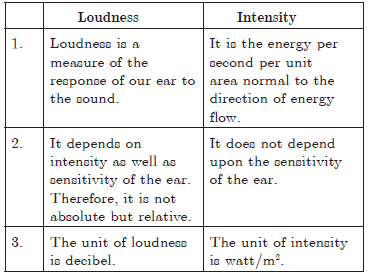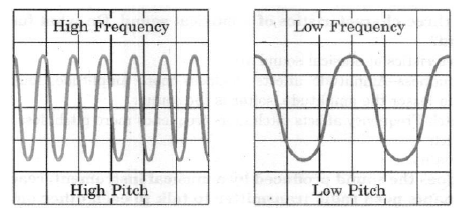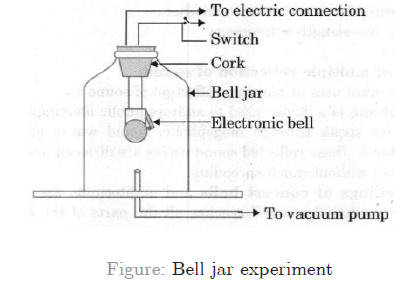Please refer to Sound Chapter 12 Class 9 Science Assignments below. We have provided important questions and answers for Sound which is an important chapter in Class 9 Science. Students should go through the notes and also learn the solved assignment with solved questions provided below. All examination and class tests questions are as per the latest syllabus and books issued by CBSE, NCERT, and KVS. We have also provided Class 9 Science Assignments for all chapters on our website.
Chapter 12 Sound Class 9 Science Assignments
Question. Flash and thunder are produced simultaneously. But, thunder is heard a few seconds after the flash is seen, why?
Answer
The speed of light is 3 × 108 ms–1 whereas that of sound is 344 ms–1 in air. Thus, flash of lightning is seen at once, but sound takes few seconds to reach our ears.
Question. The frequency of a source of sound is 100 Hz. How many times does it vibrate in a minute?
Answer
No. of vibrations produced in 1 s = 100
No. of vibrations produced in 60 (sec) = 1 min = 100 × 60 = 6000.
Question. Name the two types of mechanical waves.
Answer
The two types of mechanical waves are :
(i) Transverse wave and
(ii) Longitudinal wave.
Question. What is a wave?
Answer
A wave is a disturbance that travels in a medium due to repeated periodic motion of particles about their mean position – such that the disturbance is handed over from one particle to the other without the actual motion of the medium.
Question. What is a transverse wave?
Answer
It is a wave in which the particles of the medium vibrate perpendicular to the direction of propagation of the wave.
Question. What is a longitudinal wave?
Answer
It is a wave in which the particles of the medium vibrate in the direction of propagation of the wave.
Question. What is a trough?
Answer
A trough is a depression in a wave, i.e., maximum displacement in the negative direction (below the mean position).
Question. What do you mean by a wave?
Answer
A wave is a vibratory disturbance in a medium which carries energy from one point to another without being a direct contact between the two points.
Question. What does wave transfer-matter or energy?
Answer
Energy.
Question. What do you understand by the term ultrasonic vibrations?
Answer
Sounds of frequency higher than 20,000 Hz are called the ultrasonics.
Question. How moths of certain families are able to escape capture?
Answer
Moths of certain families can hear high frequency sounds (squeaks) of bat as they have sensitive hearing equipment. Thus, they get to know when a bat is near by and hence, able to escape its capture.
Question. What is SONAR?
Answer
SONAR (Sound Navigation And Ranging) is a technique for determining water depth and locating underwater objects, such as reefs, submarines and schools of fish.
Question. What do you understand by the term echo?
Answer
The sound heard after reflection from a rigid obstacle is called an echo.
Question. Name the term associated with the travelling disturbance in a medium.
Answer
Wave.
Question. Do waves transport energy?
Answer
Yes.
Question. Can you produce both types of waves (i.e., longitudinal and transverse) on a slinky?
Answer
Yes, we can produce both types of waves (i.e., longitudinal and transverse) on a slinky.
Question. Where is the density of air higher; at compressions or at rarefactions?
Answer
At the compression the density of air is higher.
Question. Name two animals that communicate using infrasound?
Answer
Rhinoceroses and whales communicate using infrasound.
Question. Name the waves used by bats while flying in the dark.
Answer
Bats use ultrasonic waves while flying in the dark.
Question. Name the quantity that represents the length of one complete wave.
Answer
Wavelength represents the length of one complete wave.
Question. What is the distance between two consecutive crests in a wave called?
Answer
Wavelength is the distance between two consecutive crests in a wave.
Question. Is the amplitude of a wave the same, as the amplitude of the vibrating body producing the wave?
Answer
Yes, the amplitude of a wave is same, as the amplitude of the vibrating body producing the wave.
Question. A girl claps and hears the echo after reflection from cliff which is 660 m away. If the velocity of sound is 330 ms–1, calculate the time taken for hearing the echo.
Answer
v × t =2d
t =2d/v
= (2×660)/330 = 4 s
Question. Sound is produced due to a vibratory motion, then why a vibrating pendulum does not produce sound?
Answer. The frequency of the vibrating pendulum does not lie within the audible range (20 Hz to 20,000 Hz) and hence, it does not produce audible sound.
Question. Distinguish between transverse and longitudinal waves (three points).
Answer. Transverse waves :
(i) Particles the medium vibrate at right angles.
(ii) Alternate crests and troughs formed.
(iii) e.g., water waves.
Longitudinal waves :
(i) Particles vibrate parallel to the direction of waves.
(ii) Alternate compressions, rarefaction formed.
(iii) e.g., sound waves.
Question. State three characteristics of a musical sound. On what factors do they depend?
Answer. Characteristics of musical sound are :
(i) Loudness–Amplitude affects loudness–more amplitude, louder the sound and lesser the amplitude, softer is the sound.
(ii) Pitch-Frequency affects pitch-more frequency more pitch, less frequency less pitch.
(iii) Quality.
Question. Give difference between loudness and intensity of the sound.
Answer.

Question. What are transverse waves? Give two examples.
Answer. A wave in which the particles of the medium vibrate up and down at right angle to the direction in which the wave is moving.
Example :
(i) The waves produced by moving one end of a long spring up and down rapidly.
(ii) Ripples formed on the surface of water in a pond.
Question. What are wavelength, frequency, time period and amplitude of a sound wave?
Answer. Wavelength : It is the linear distance between two consecutive compressions or two consecutive rarefactions.
Frequency : The number of compressions or rarefactions taken together passing through a point in one second is called frequency.
Time period : It is the time taken by two consecutive compressions or rarefactions to cross a point.
Amplitude : It is the magnitude of maximum displacement of a vibrating particle about its mean position.
Question. Does sound follow the same laws of reflection as light does? Explain.
Answer. Yes, sound and light follow the same laws of reflection that are given below :
(a) Angle of incidence at the point of incidence = Angle of reflection. (∠+i = +∠r)
(b) At the point of incidence, the incident sound wave, the normal and the reflected sound wave lie in the same plane.
Question. What are longitudinal waves? Give two examples.
Answer. A wave in which the particles of the medium vibrate back and forth along the same direction, in which the wave is moving, is called a longitudinal wave.
Examples :
(a) The sound waves in air.
(b) The waves produced in air when a sitar wire is plucked.
Question. Distinguish between tone and note.
Answer. A pitch is a particular frequency of sound, for example : 440 Hz.
A note is a named pitch. For example : Western music generally refers to the 440 Hz pitch as A, specifically A4.
Question. A longitudinal wave of wavelength 1 cm travels in air with a speed of 330 ms–1. Calculate the frequency of the wave. Can this wave be heard by a normal human being?
Answer.
Given l = 1 cm = 0.01 m
v = 330 ms–1
Using v = nλ we have
v=n/λ
= 330/0.01 = 33000 Hz
No, this cannot be heard by a normal human being.
Question. If the amplitude of a wave is doubled, what will be the effect on its loudness?
Answer. Loudness depends upon the square of the amplitude of the wave, therefore, when the amplitude of wave is doubled, the loudness becomes four times.
Question. How do the frequency and amplitudes affect a musical sound?
Answer. The ‘frequency’ of a musical sound affects its ‘pitch’.The more the frequency of a (musical) sound, the
‘sharper’ and ‘shriller’ the sound becomes. The ‘amplitude’ of a musical sound affects its loudness, or intensity. The more the amplitude of the sound, the louder (or more intense) the sound is.
Question. How does the sound produced by a musical instrument, reach your ears? Astronauts need radio transmitter to talk to each other on Moon. Why?
Answer. The sound produced by the musical instrument makes the molecules of air vibrate. These vibrations are carried forward by the other molecules till they reach our ear. These then vibrate our eardrum to produce sound. Since, sound requires a medium to propagate, therefore, sound cannot travel between astronauts on the Moon, hence, they use radio transmitters.
Question. Mention one practical use of echoes.
Answer.Echoes are used in radars to estimate the distance of flying objects.
Question. When a sound is reflected from a distant object, an echo is produced. Let the distance between the reflecting surface and the source of sound production remains the same. Do you hear echo sound on a hotter day?
Answer.If the temperature rises, the speed of sound will increase. This in turn will increase the minimum distance required for hearing an echo. No echo is heard because the distance between the source of sound and reflecting body does not increase.
Question. (i) State two characteristics of wave motion.
(ii) What is the relation between frequency,wavelength and speed of a wave?
Answer.
(i) A wave motion is periodic in nature. The particles of the medium do not move from their mean position but execute vibration but only the energy is transmitted from one point to another.
(ii) Speed = wavelength × frequency
v = λ×n
Question. (i) Draw the sound waves for a low pitched and the high pitched sound.
(ii) Write one use of ultrasonography.
(ii) Which wave property determines pitch?
Answer.
(i) The diagram is as shown :

Figure: Frequency of sound wave
(ii) Ultrasonography is used for examination of the fetus during pregnancy to detect congenital defects and growth abnormalities.
(iii) The pitch depends on frequency.
Question. Give uses of multiple reflection of sound.
Answer. There are several uses of multiple reflection of sound :
(i) Megaphone is a device used to address public meetings. It is horn-shaped. When we speak through megaphone, sound waves are reflected by the megaphone. These reflected sound waves are directed towards the people (or audience) without much spreading.
(ii) The ceilings of concert halls and auditoriums are made curved. This is done so that the sound reaches all the parts of the hall after reflecting from the ceiling. Moreover, these ceilings are made up of sound absorbing materials to reduce the reverberation.
(iii) Stethoscope is a device used by doctors to listen the sound produced by heart and lungs. The sound produced by heart beat and lungs of a patient reaches the ears of a doctor due to multiple reflection of sound.
(iv) Sound boards are curved surfaces (concave) which are used in a big hall to direct the sound waves towards the people sitting in a hall. The speaker is (i.e., source of sound) placed at the focus of the sound board.
(v) Sound waves from the speaker are reflected by die sound board and these reflected waves are directed towards the people (or audience).
(vi) Hearing aid is used by a person who is hard of hearing. The sound waves falling on hearing aid are concentrated into a narrow beam of sound waves by reflection. This narrow beam of sound waves is made to fall on the diaphragm of the ear. Thus, diaphragm of the ear vibrates with large amplitude. Hence, the hearing power of the person is improved.
Question. With the help of a labelled diagram show that sound needs a material medium for its propagation.
Answer. A well labelled diagram is as shown :

(i) Take an electric circuit which consists of a cell, a switch and an electric bell arranged inside a bell jar, which stands on the platform of an evacuating pump.
(ii) The switch of the bell is pressed to close the electric circuit. When there is air within the bell jar, sound is heard. Air is now pumped out of the bell jar. When the air is completely removed from the bell jar, no sound is heard as it is obvious from fig. because the medium of air which has to carry energy from the bell to the bell jar is removed. It shows that sound needs material medium for its propagation.
Numerical Questions
Question. A stone is dropped into a well 44.1 m deep. The splash is heard 3.13 seconds after the stone is dropped. Find the velocity of sound in air.
Answer.
Stone falling from A to B
u = 0, s = 44.1 m, g = 9.8 ms–2, t = ?
s = ut + 1/2 gt2
44.1 = 1/2 × 9.8 × t2
t = 3 s
Sound produced at B, due to sound produced by the stone falling on the surface of water, travels from B to
A. The sound moves with constant velocity.
Speed = Distance/ Time
v = 44.1/t’
t’ = 44.1/v
= 44 1
It is given that the total time is 3.13 second.
i.e. t + t’ = 3.13
3+ 44.1/ v = 3.13
44.1 / v= 0.13
v = 339.2 ms–1
Question. Using sonar, sound pulses are emitted at the surface of water. These pulses after being reflected from water bottom are detected. If the time interval from the emission to the detection of the sound pulses is 2 seconds, find the depth of the water. (speed of sound in water = 1531 m/s given)
Answer.
t = 2 s
Speed = Distance/Time
1531 = 2x/2
x = 1531 m
Question. Calculate (a) the wavelength (b) the time period of a tuning fork of frequency 512 Hz which is set to vibrate. Velocity of sound in air is 320 m/s.
Answer.Frequency of the tuning fork (n ) = 512 Hz
Velocity of sound (v ) = 320 m/s
Wavelength (λ ) =n /v
= 320/512
= 0.625
time period (t)=1/v
= 0.00195 s
Question. Sound waves travel with a speed of 330 m/s. What is the wavelength of sound, whose frequency is 550 Hz?
Answer. Speed of the sound wave (v ) = 330 m/s
Frequency of the sound wave (n ) = 550 Hz
Wavelength (l ) n/v = 330/550 =33/55
Wavelength = 0.6 m
Question. Derive a relation between wave-velocity, frequency and wavelength.
Answer. Wave velocity is defined as the distance travelled by the wave in one second.
Wave velocity = Distance travelled by one wave/ Time taken by one wave
= Wavelength/Time
But 1/t = v
So, Wave velocity = Wavelength × Frequency
Question. Radiowaves of speed 3 × 108 m s–1 are reflected off the Moon and received back on Earth. The time elapsed between the sending of the signal and receiving it back at the Earth station is 2.5 s. What is the distance of the Moon from the Earth?
Answer.
d = v × t/2
= (3×108×2.5)/2
= (7.5×108)/2= 3.75 × 108 m
Question. A longitudinal wave of wavelength 1 cm travels in air with a speed of 330 ms–1. Calculate the frequency of the wave. Can this wave be heard by a normal human being?
Answer.
v = nλ
n =v/λ
= 330 /0.01= 33,000 Hz
The sound is not audible to human ear because frequency 20 to 20,000 Hz is the audible range of human ear.
Question. A person standing between two vertical cliffs and 640 m away from the nearest cliff shouted. He heard the 1st echo after 4 seconds and the second echo 3 seconds later. Calculate : (i) the velocity of sound in air and
(ii) the distance between the cliff.
Answer.
Velocity of sound (v ) t
= 2d/t= (2×640)/4 = 320 m s–1
Distance the farthest cliff,
d=(v× t)/2
= (320×7)/2 = 1120 m
Therefore the distance between the cliffs,
D = 640 + 1120 = 1760 m
Question. A ship on the surface of water sends a signal and receives it back after 4 seconds from a submarine inside the water. Calculate the distance of the submarine from the ship (The speed of sound in water is 1450 ms–1).
Answer.
v = 2d/t
d= (v×t)/2
= (1450×4)/2
= 2900 m or 2.9 km
Question. A man fires a gun and hears its echo after 5 seconds.The man then moves 310 m towards the hill and fires his gun again. This time he hears the echo after 3 seconds. Calculate the speed of sound.
Answer.
Let d be the distance between the man and the hill in
the beginning.
v= 2d/t
=2d/5 …..(1)
He moves 310 m towards the hill. Therefore, the distance will be (d – 310) m.
v=[2(d – 310)]/3 …..(2)
Since, velocity of sound is same, equating (1) and (2),
we get
2d/5 =[2(d – 310)]/3
3d = 5d – 1550
2d = 1550
d = 775 m
Velocity of sound (v )
= (2×775)/5
= 310 m s–1
Question. A longitudinal wave is produced on a toy slinky. The wave travels at a speed of 30 cm/s and the frequency of the wave is 20 Hz. What is the minimum separation between the consecutive compressions of the slinky?
Answer.
Wave speed, n = 30 cm/s
Frequency of the wave, n = 20 Hz = 20s–1
The minimum separation between the consecutive compressions is equal to the wavelength. Therefore,
Wavelength=30 cms–1/20s–1=1.5
Thus, the minimum separation between the consecutive compression of the slinky is 1.5 cm.

